Single Period Workshops
Single period workshops have been designed to be completed within 45-90 minutes, and engage students by involving them in the presentation. A list of the various topics can be found below:
The Moon
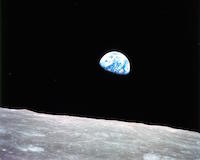
Earth rise as seen from the Moon (NASA)
The aim of this presentation is to expose students to the Earth-Moon system and the impact this system has on the Earth. This presentation is activity driven, with the students actively playing out the roles of the Moon, Earth and Sun. With a personal model Moon, students will create the phases of the Moon by turning on the spot a set distance from a model Sun. Students will also see the effects of the various eclipses using these techniques.
In addition, this presentation will also describe what we can observe of the Moon using just our eyes or a basic pair of binoculars, including the terminator, the lunar highlands and mare.
Recommended Age Group: Grade 1-6
Resources:
Curriculum Connections:
Grade 6 (Understanding Earth and Space Systems - Daily and Seasonal Changes)
2.4 use scientific inquiry/research skills, including generating questions about knowledge acquired from previous investigations, to identify daily and/or seasonal changes and their effects ( e.g., the sun shines during the day, and the moon and stars are visible at night)
Grade 6 (Understanding Earth and Space Systems - Space)
2.4 use appropriate science and technology vocabulary, including axis, tilt, rotation, revolution, planets, moons, comets, and asteroids, in oral and written communication
3.1 identify components of the solar system, including the sun, the earth, and other planets, natural satellites, comets, asteroids, and meteoroids, and describe their physical characteristics in qualitative terms
3.2 identify the bodies in space that emit light ( e.g., stars) and those that reflect light ( e.g., moons and planets)
3.5 describe the effects of the relative positions and motions of the earth, moon, and sun (e.g., use models or simulations to show solar and lunar eclipses, phases of the moon, tides)
Grade 9 (Academic Science)
D2.3 simulate interrelationships between celestial objects visible in the night sky (p. 55)
D2.4 identify properties of celestial objects in our solar system (e.g. planetary surfaces, etc.) (p. 55)
D2.5 compare and contrast properties of planetary bodies (Earth/Moon) (p.55)
D3.3 describe solar system components using appropriate scientific terminology (p.55)
D3.5 explain the causes of astronomical phenomena and how they can be observed (p.55)
Grade 9 (Applied Science)
D2.2 investigate patterns in the night sky (e.g., constellations) and the motion of celestial objects (e.g., the sun, our moon, planets, stars, galaxies), using direct observation, computer simulations, and/or star charts, and record the information using a graphic organizer or other format
D3.5 describe the causes of major astronomical phenomena and how various phenomena can best be observed from Earth
Grade 12 (Earth and Space Science)
C2.4 investigate the ways in which interactions between solid bodies have helped to shape the solar system, including Earth
C3.4 identify the factors that determined the properties of bodies in the solar system
C3.9 describe the major external processes and phenomena that affect Earth
Mining Space
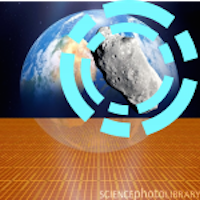
Conceptualization of the industrialization of space
As our own planet’s resources are being depleted, are there other places we should begin to look to replenish those supplies? Not just science fiction anymore, this presentation will focus on the scientifically viable options currently being explored for off-world resources. If the organizer wishes, this presentation can be combined with the hands-on activity, the space lander challenge for greater student interaction.
Recommended Age Group: Grade 4-9
Resources:
Curriculum Connections:
Grade 9 (Academic Science)
D1.1 assess, on the basis of research, and report on the contributions of Canadian governments, organizations, businesses, and/or individuals to space technology, research, and/or exploration
D1.2 assess some of the costs, hazards, and benefits of space exploration taking into account the benefits of technologies that were developed for the space program but that can be used to address environmental and other practical challenges on Earth
D3.6 describe various reasons that humankind has had for studying space (e.g., to develop calendars for agricultural purposes, to forecast weather, for celestial navigation, for religious inspiration) and the conceptions of the universe held by various cultures and civilizations
E1.2 assess some of the social, economic, and environmental implications of the production of electrical energy in Canada from renewable and non-renewable sources
Grade 9 (Applied Science)
D1.2 assess the contributions of Canadians to space exploration
D3.4 describe the characteristics of the sun and the effects of its energy on Earth and Earth’s atmosphere
E1.1 assess social, economic, and environmental costs and benefits of using a renewable and a non-renewable source of electrical energy
Grade 9 (Academic Geography)
C2.1 explain how the availability and spatial distribution of key natural resources, including water, in Canada are related to the physical geography of the country, and assess the significance of their availability and distribution,nationally and globally
Grade 9 (Applied Geography)
C3.2 describe the location, use, and importance of selected natural resources, including water resources, that are found in Canada, and compare the availability of these resources with their availability in the rest of the world
Exploring Mars** Available Virtually
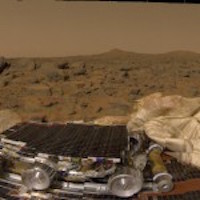
Martian Landscape, Pathfinder camera (NASA)
Why study Mars? This presentation discusses the atmosphere, surface, landscape features, exploration and our fascination for Mars. It compares the seasons of Earth and Mars, and investigates the climate on the two planets. The contribution of Canadian organizations to the study of Mars is also examined. Students will have an opportunity to try their hand at mapping a region of Mars individually and subsequently will have to work with a team to compile a regional map together.
Recommended Age Group: Grade 3-12
Resources:
Curriculum Connections:
Grade 6 (Science)
1.1 assess the contributions of Canadians (e.g., astronauts Marc Garneau and Roberta Bondar; astronomers Richard Bond, David Levy, and Helen Hogg; Spar Aerospace Limited’s development of the Canadarm; the University of British Columbia’s development of the “Humble”space telescope) to the exploration and scientific understanding of space
3.1 identify components of the solar system, including the sun, the earth, and other planets, natural satellites, comets, asteroids, and meteoroids, and describe their physical characteristics in qualitative terms
3.4 identify the technological tools and devices needed for space exploration
Grade 9 (Academic Science)
D1.1 assess, on the basis of research, and report on the contributions of Canadian governments, organizations, businesses, and/or individuals to space technology, research, and/or exploration (e.g., as part of the International Space Station mission; in the fields of telecommunications and satellite technology) [IP, PR, AI, C]
D2.5 compare and contrast properties of celestial objects visible in the night sky, drawing on information gathered through research and using an appropriate format (e.g., compare the size of planets; represent the distance of stars from Earth using scientific notation; compare star temperatures and colour) [PR, AI, C]
Grade 9 (Applied Science)
D1.2 assess the contributions of Canadians to space exploration (e.g., as astronauts; in research and development) [AI, C]
D3.2 compare the characteristics and properties of celestial objects that constitute the solar system, including their motion and their distance from other celestial objects in the solar system (e.g., composition, size, rotation, presence and composition of atmosphere, gravitational pull, magnetic field)
Grade 12 (Earth and Space Science)
C3.5 identify and explain the properties of celestial bodies within or beyond the solar system, other than Earth, that might support the existence of life (e.g., the possible existence of liquid water on Europa; the proximity of a body to its host star)
C3.6 compare Earth with other objects in the solar system with respect to properties such as mass, size, composition, rotation, magnetic field, and gravitational field
Benefits and Challenges of Space Exploration** Available Virtually
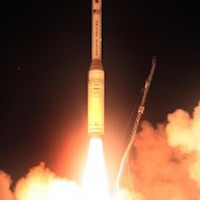
Tarus booster lift-off (Orbital Sciences Crop.)
This presentation will discuss the hazards of human space flight and outline some of the challenges scientists and engineers face when trying to get to space. It will address the challenges of humans physically going to space, working in space, and of returning to the Earth, as well as the hazards of the space and planetary environments. Students will then participate in an engineering challenge where they design and create a "space lander". If the organizer wishes, this presentation can be supplemented with a space exploration debate.
Recommended Age Group: Grade 4-9
Resources:
Curriculum Connections:
Grade 9 (Academic Science)
C1.1 assess the usefulness of and/or the hazards associated with common elements or compounds in terms of their physical and chemical properties
D1.2 assess some of the costs, hazards, and benefits of space exploration
Grade 9 (Applied Science)
D1.1 research the challenges associated with space exploration, and explain the purpose of materials and technologies that were developed to address these challenges and how these materials and technologies are now used in other fields of endeavour
D2.4 investigate a technological challenge related to the exploration of celestial objects that arises from the objects’ specific properties, and identify the solution that has been devised
D3.3 identify the factors that make Earth well suited for the existence of life
Grade 12 (Earth and Space Sciences)
C2.3 use an inquiry or research process to investigate the effects of various forms of radiation and high-energy particles on bodies, organisms, and devices within the solar system
C2.5 investigate the properties of Earth that protect life from hazards such as radiation and collision with other bodies
Grade 12 (Biology)
D3.4 explain how mutagens, such as radiation and chemicals, can cause mutations by changing the genetic material in cells
Spin Off Technology
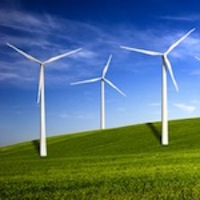
Tarus booster lift-off (Orbital Sciences Crop.)
What would life be like without space exploration? Students will learn about a variety of spinoff technologies while competing in three rounds of fun activities.
Recommended Age Group: Grade 4-9
Resources:
Curriculum Connections:
Grade 9 (Academic Science)
D1.2 assess some of the costs, hazards, and benefits of space exploration, taking into account the benefits of technologies that were developed for the space program but that can be used to address environmental and other practical challenges on Earth
Grade 9 (Applied Science)
D1.1 research the challenges associated with space exploration, and explain the purpose of materials and technologies that were developed to address these challenges and how these materials and technologies are now used in other fields of endeavour
Grade 12 (Earth and Space Science)
C1.2 analyse, on the basis of research, a specific technology that is used in space exploration and that has applications in other areas of research or in the environmental sector
Meteorites: Rocks from Space
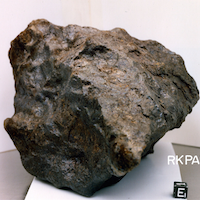
Meteorite RKPA 79015 (NASA)
This presentation will explore the origins of meteorites, where they come from, how they get here and what they can tell us about the Earth, our solar system, and even the origin of life. It will also go into the collection of meteorites and why the best place on Earth to look for them is Antarctica. Through our Mission Meteorite workshop, We offer hands-on station-based multi-period activity t o help students understand the different types of meteorites. Students will have the opportunity to handle real meteorite samples, use microscopy to differentiate samples. Learn more about the Mission Meteorite workshop here!
Recommended Age Group: Grade 6-12
Resources:
Curriculum Connections:
Grade 9 (Academic Science)
D2.4 gather and record data, using an inquiry or research process, on the properties of specific celestial objects within the solar system
D3.2 describe observational and theoretical evidence relating to the formation of the solar system
D3.5 explain the causes of astronomical phenomena and how various phenomena can best be observed from Earth
D3.6 describe various reasons that humankind has had for studying space
Grade 9 (Applied Science)
D2.3 use a research process to compile and analyse information on the characteristics of various objects in the universe
D3.2 compare the characteristics and properties of celestial objects that constitute the solar system, including their motion and their distance from other celestial objects in the solar system
D3.5 describe the causes of major astronomical phenomena and how various phenomena can best be observed from Earth
Grade 12 (Earth and Space Science)
C2.2 identify geological features and processes that are common to Earth and other bodies in the solar system (e.g., craters, faults, volcanic eruptions), and create a model or illustration to show these features, using data and images from satellites and space probes
C2.4 investigate the ways in which interactions between solid bodies have helped to shape the solar system, including Earth (e.g., the accretion of minor bodies)
C3.3 explain the formation of the solar system with reference to the fundamental forces and processes involved
Tour of the Solar System** Available Virtually

Solar system montage (NASA)
Looking at the solar system through different eyes, this presentation will explore those solar-system bodies that are less frequently discussed.
This activity can be combined with Mission Meteorite to give students a better understanding through hands-on interaction with the planetary material discussed in the presentation.
Recommended Age Group: Grade 1-6
Resources:
Curriculum Connections:
Grade 1 (Understanding Earth and Space Systems)
3.1 identify the sun as Earth’s principal source of heat and light
Grade 1 (Understanding Matter and Energy)
3.2 demonstrate an understanding that the sun, as the earth’s principal source of energy, warms the air, land, and water; is a source of light for the earth; and makes it possible to grow food
Grade 6 (Understanding Earth and Space Systems)
2.2 use technological problem-solving skills (see page 16) to design, build, and test devices (e.g., a sundial, a model of the earth’s rotation
around the sun) for investigating the motions of different bodies in the solar system
2.4 use appropriate science and technology vocabulary, including axis, tilt, rotation, revolution, planets, moons, comets, and asteroids, in oral
and written communication
3.1 identify components of the solar system, including the sun, the earth, and other planets, natural satellites, comets, asteroids, and meteoroids, and describe their physical characteristics in qualitative terms
Grade 9 (Academic Science) Earth and Space Science: The Study of the Universe
D2.1 use appropriate terminology related to the study of the universe, including, but not limited to: celestial objects, orbital radius, retrograde motion, and satellite
D2.5 compare and contrast properties of celestial objects visible in the night sky, drawing on information gathered through research and using
an appropriate format (e.g., compare the size of planets; represent the distance of stars from Earth using scientific notation; compare star
temperatures and colour)
D3.3 describe the major components of the solar system and the universe (e.g., planets, stars, galaxies), using appropriate scientific terminology and units
D3.4 describe the sun’s composition and energy source, and explain how its energy warms Earth and supports life on the planet (e.g., with
reference to the types of radiation the sun emits and the interaction of the sun’s energy with Earth’s atmosphere)
Grade 9 (Applied Science) Earth and Space Science: Space Exploration
D2.1 use appropriate terminology related to space exploration, including, but not limited to: astronomical units, gravitational pull, and universe
D3.1 describe the major components of the universe (e.g., planets, moons, stars, galaxies), the motion of the different types of celestial objects, and the distances between certain objects, using appropriate scientific terminology and units
D3.2 compare the characteristics and properties of celestial objects that constitute the solar system, including their motion and their distance from other celestial objects in the solar system
D3.4 describe the characteristics of the sun and the effects of its energy on Earth and Earth’s atmosphere
Grade 12 (Earth and Space Sciences)
B3.2 explain the scale of distances between celestial bodies (e.g., with reference to astronomical units, light years, and parsecs) and the methods astronomers use to determine these distances (e.g., stellar parallax, cepheid variables)
C3.1 explain the composition of the solar system (e.g., the sun, terrestrial inner planets, the asteroid belt, gas giant outer planets, the
Kuiper belt, the scattered disc, the heliopause, the Oort cloud), and describe the characteristics of each component
C3.2 identify and explain the classes of objects orbiting the sun (e.g., planets, dwarf planets, small solar system bodies
C3.4 identify the factors that determined the properties of bodies in the solar system (e.g., differences in distance from the sun result in
temperature variations that determine whether substances on a planet, moon, or other body are solid or gaseous)
C3.6 compare Earth with other objects in the solar system with respect to properties such as mass, size, composition, rotation, magnetic field, and gravitational field
Astrobiology: The search for life** Available Virtually
What is life? How do we look for it? This presentation will focus on those very questions. Students will have the opportunity to learn about the microorganisms that have given us clues to the answers and forced us to redefine those same answers.
The above stated presentations can be accompained with relevant hands-on activties to increase interaction and engagement or could be done as stand alone activity.
Resources:
Curriculum Connections:
Grade 9 (Academic Science)
D3.4 describe the sun’s composition and energy source, and explain how its energy warms Earth and supports life on the planet
Grade 9 (Applied Science)
D3.3 identify the factors that make Earth well suited for the existence of life
Grade 11 (Biology, Diversity of Living Things)
B3.2 compare and contrast the structure and function of different types of prokaryotes, eukaryotes, and viruses (e.g., compare and contrast genetic material, metabolism, organelles, and other cell parts)
Grade 12 (Earth and Space Sciences)
C3.5 identify and explain the properties of celestial bodies within or beyond the solar system, other than Earth, that might support the existence of life
Grade 12 (Biology)
C1.1 analyse the role of metabolic processes in the functioning of and interactions between biotic and abiotic systems
Space Lander Challenge
The challenge is to work as a team to design and build a device that will land a simulated space probe (a ping-pong ball with a piece of cardboard on the top simulate solar panels) upright after a drop from 1.5m.
Length of the workshop: 1 hour
Recommended Age Group: Grade 4 to 8
Resources:
Curriculum Connections:
Grade 6
2.2 use technological problem-solving skills (see page 16) to design, build, and test devices (e.g., a sundial, a model of the earth’s rotation around the sun) for investigating the motions of different bodies in the solar system
3.4 identify the technological tools and devices needed for space exploration
Robotic Arm Challenge
Students are tasked with building a robotic arm with a minimum of 3 working joints that can grasp an asteroid (rock) from space (the floor) and deposit it in the cargo bay of the space station (the tabletop). Students are introduced to the Canadarm and Dextre - Canadian contributions to Space Exploration.
Length of the workshop: 1 hour
Recommended Age Group: Grade 6 to 12
Resources:
Curriculum Connections:
Grade 6 (Science)
1.1 assess the contributions of Canadians (e.g., astronauts Marc Garneau and Roberta Bondar; astronomers Richard Bond, David Levy, and Helen Hogg; Spar Aerospace Limited’s development of the Canadarm; the University of British Columbia’s development of the “Humble”space telescope) to the exploration and scientific understanding of space
2.3 use scientific inquiry/research skills (see page 15) to investigate scientific and technological advances that allow humans to adapt to life in space
3.4 identify the technological tools and devices needed for space exploration (e.g., telescopes, spectroscopes, spacecraft, life-support systems)
Space Exploration Debate
A long-standing debate among planetary scientists, politicians, and the public alike: should humans explore space? In this activity, students break into groups depending on their opinions (yes to human exploration, yes to robotic-only exploration, no to both, and undecided) and then get to debate the issues with guidance from experts.
Length of the workshop: 1.5 hours
Recommended Age Group: Grade 3 to 7
Curriculum Connections:
Grade 6 (Understanding Earth and Space Sciences)
1.2 evaluate the social and environmental costs and benefits of space exploration, taking different points of view into account
2.3 use scientific inquiry/research skills (see page 15) to investigate scientific and technological advances that allow humans to adapt to life in space
3.4 identify the technological tools and devices needed for space exploration
Grade 9 (Academic Science)
D1.2 assess some of the costs, hazards, and benefits of space exploration (e.g., the expense of developing new technologies, accidents resulting in loss of life, contributions to our knowledge of the universe), taking into account the benefits of technologies that were developed for the space program but that can be used to address environmental and other practical challenges on Earth (e.g., radiation monitors and barriers, sensors to monitor air and water quality, remote sensing technology, fire-resistant materials) [AI, C]
Space Mission Design** Available Virtually
Students will be introduced to the aspects of designing a space mission, in particular a Mission to Mars. They will be given a budget, mass limit and power limit in order to design a mission. They will be provided with all the information required to design either a orbiter, lander or a rover mission to Mars using cards and a design mat. In the process, they will be learning about the various features on Mars and their importance.
Recommended Age Group: Grade 4-12
Curriculum Connections:
Grade 6
1.2 evaluate the social and environmental costs and benefits of space exploration, taking different points of view into account
2.3 use scientific inquiry/research skills (see page 15) to investigate scientific and technological advances that allow humans to adapt to life in space
3.4 identify the technological tools and devices needed for space exploration
Grade 9 Academic
A1.11 communicate ideas, plans, procedures, results, and conclusions orally, in writing, and/or in electronic presentations, using appropriate language and a variety of formats
A2.1 identify and describe a variety of careers related to the fields of science under study
D1.2 assess some of the costs, hazards, and benefits of space exploration taking into account the benefits of technologies that were developed for the space program but that can be used to address environmental and other practical challenges on Earth
Grade 9 Applied
A1.11 communicate ideas, plans, procedures, results, and conclusions orally, in writing, and/or in electronic presentations, using appropriate l anguage and a variety of formats
A2.1 identify and describe a variety of careers related to the fields of science under study
D1.1 research the challenges associated with space exploration, and explain the purpose of materials and technologies that were developed to address these challenges and how these materials and technologies are now used in other fields of endeavour
Remote Sensing** Available Virtually
Remote sensing refers to the use of satellites to gather information on distant planetary bodies. In this activity, students will use remote sensing techniques to develop an elevation map of an unknown surface feature hidden inside a shoebox. This is comparable to how satellites map surfaces of planets that have thick atmospheres, such as Venus.
Recommended Age Group: Grade 4-9
Curriculum Connections:
Grade 6 (Space):
2.5 use a variety of forms (e.g., oral, written, graphic,multimedia) to communicate with different audiences and for a variety of purposes
3.4 identify the technological tools and devices needed for space exploration
Grade 9 (Academic Science)
D2.1 use appropriate terminology related to the study of the universe, including, but not limited to: celestial objects, orbital radius, retrograde motion, and satellite
Grade 9 (Applied Science)
D2.1 use appropriate terminology related to space exploration, including, but not limited to: astronomical units, gravitational pull, and universe
D2.4 investigate a technological challenge related to the exploration of celestial objects that arises from the objects’ specific properties, and identify the solution that has been devised

